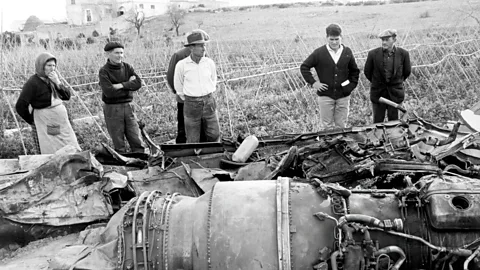'We thought it was the end of the world': How the US dropped four nuclear bombs on Spain in 1966
 Alamy
AlamyIn 1966, the remote Spanish village of Palomares found that the "nuclear age had fallen on them from a clear blue sky". Two years after the terrifying accident, BBC reporter Chris Brasher went to find what happened when the US lost a hydrogen bomb.
On 7 April 1966, almost 60 years ago this week, a missing nuclear weapon for which the US military had been desperately searching for 80 days was finally found. The warhead, with an explosive power 100 times that of the bomb dropped on Hiroshima, was carefully winched from a depth of 2,850ft (869m) out of the Mediterranean Sea and delicately lowered onto the USS Petrel. Once it was on board, officers painstakingly cut into the thermonuclear device's casing to disarm it. It was only then that everyone could breathe a sigh of relief – the last of the four hydrogen bombs that the US had accidentally dropped on Spain had been recovered.
"This was not the first accident involving nuclear weapons," said BBC reporter Chris Brasher when he reported from the scene in 1968. "The Pentagon lists at least nine previous accidents to aircraft carrying hydrogen bombs. But this was the first accident on foreign soil, the first to involve civilians and the first to excite the attention of the world."
This terrifying situation had come about because of a US operation code-named Chrome Dome. At the beginning of the 1960s, the US had developed a project to deter its Cold War rival, the Soviet Union, from launching a pre-emptive strike. A patrol of nuclear-armed B-52 bombers would continuously criss-cross the skies, primed to attack Moscow at a moment's notice. But to stay airborne on these long looping routes, the planes needed to refuel while in flight.
On 17 January 1966, one such bomber was flying at a height of 31,000ft (9.5km) over the Almería region of southern Spain, and attempted a routine air-to-air refuelling with a KC-135 tanker plane. "I believe what happened was the bomber was closing at a too-high rate of closure speed and he didn't stabilise his position," US Maj Gen Delmar Wilson, the man in charge of dealing with the catastrophic accident, told Brasher, "with the result that they got too close and collided."
The B-52 bomber's impact with the refuelling plane tore it open, igniting the jet fuel the KC-135 was carrying and killing all four of the crew onboard. The ensuing explosion also killed two men in the B-52's tail section. A third managed to eject, but died when his parachute did not open. The other four of the bomber's crew successfully bailed out of their burning plane before it broke apart and fell to earth, raining down both flaming aircraft fragments and its lethal thermonuclear cargo onto the remote Spanish village of Palomares.
The huge fireball was seen a mile away. Thankfully, it did not trigger a nuclear explosion. The bomber's warheads were not armed and had built-in safeguards to prevent an unintended atomic chain reaction. But the thermonuclear devices did have explosives surrounding their plutonium cores as part of the triggering mechanism. In the event of an accident, the bombs had parachutes attached to them designed to cushion the impact on landing and prevent radioactive contamination. And indeed, one undetonated bomb did land safely in a riverbed and was recovered intact the following day. Unfortunately, two of the plummeting nuclear bombs' parachutes failed to open.
That morning, Spanish farmer Pedro Alarcón was walking to his house with his grandchildren when one of the nuclear bombs landed in his tomato field and blew apart on impact. "We were blown flat. The children started to cry. I was paralysed with fear. A stone hit me in the stomach, I thought I'd been killed. I lay there feeling like death with the children crying," he told the BBC in 1968.
Devastation and chaos
The other hydrogen bomb also exploded when it hit the ground near a cemetery. These dual blasts created vast craters and scattered highly toxic, radioactive plutonium dust across several hundred acres. Burning aircraft debris also showered the Spanish village. "I was crying and running about," a villager called Señora Flores told the BBC in 1968. "My little girl was crying, 'Mama, Mama, look at our house, it is burning.' Because of all the smoke I thought what she said must be true. There were a lot of stones and debris falling around us. I thought it would hit us. It was this terrific explosion. We thought it was the end of the world."
Once the news that the bomber had come down with nuclear weapons aboard reached US military command, a huge operation was launched. At the time of the disaster, Capt Joe Ramirez was an US Air Force lawyer stationed in Madrid. "There were a lot of people talking, there was a lot of excitement in the conference room. Everyone kept talking about a 'broken arrow'. I learnt then that 'broken arrow' was the code word for a nuclear accident," he told BBC's Witness History in 2011.
US military personnel were scrambled to the area by helicopter. When Capt Ramirez arrived in Palomares, he immediately saw the devastation and chaos wrought by the accident. Huge pieces of smoking wreckage were strewn all over the area – a large part of the burning B-52 bomber had landed in the school's yard. "It's a small village but there were people scrambling in different directions. I could see smouldering debris, I could see some fires."
IN HISTORY
In History is a series which uses the BBC's unique audio and video archive to explore historical events that still resonate today. window._taboola = window._taboola || []; _taboola.push({ mode: 'alternating-thumbnails-a', container: 'taboola-below-article', placement: 'Below Article', target_type: 'mix' });
